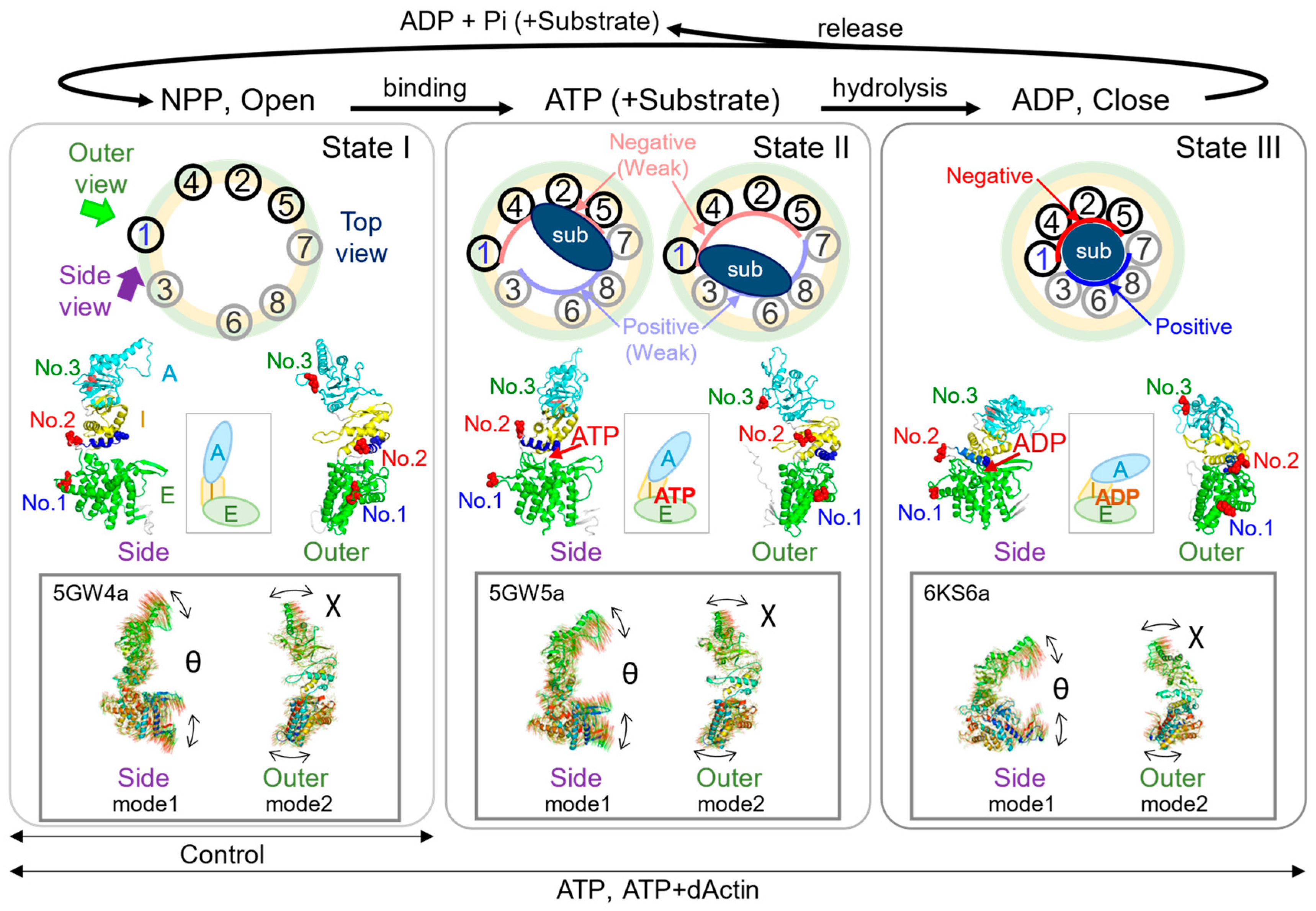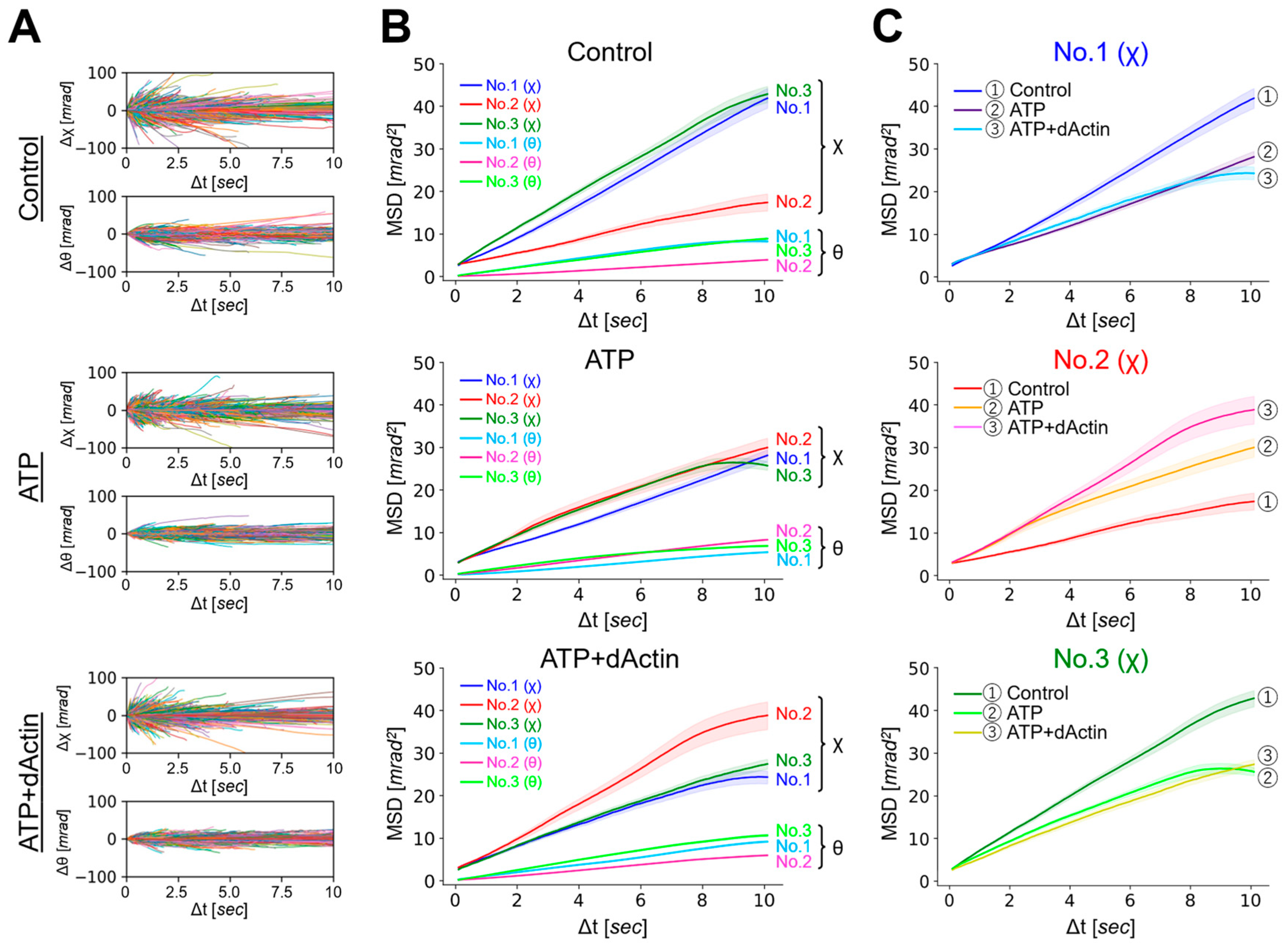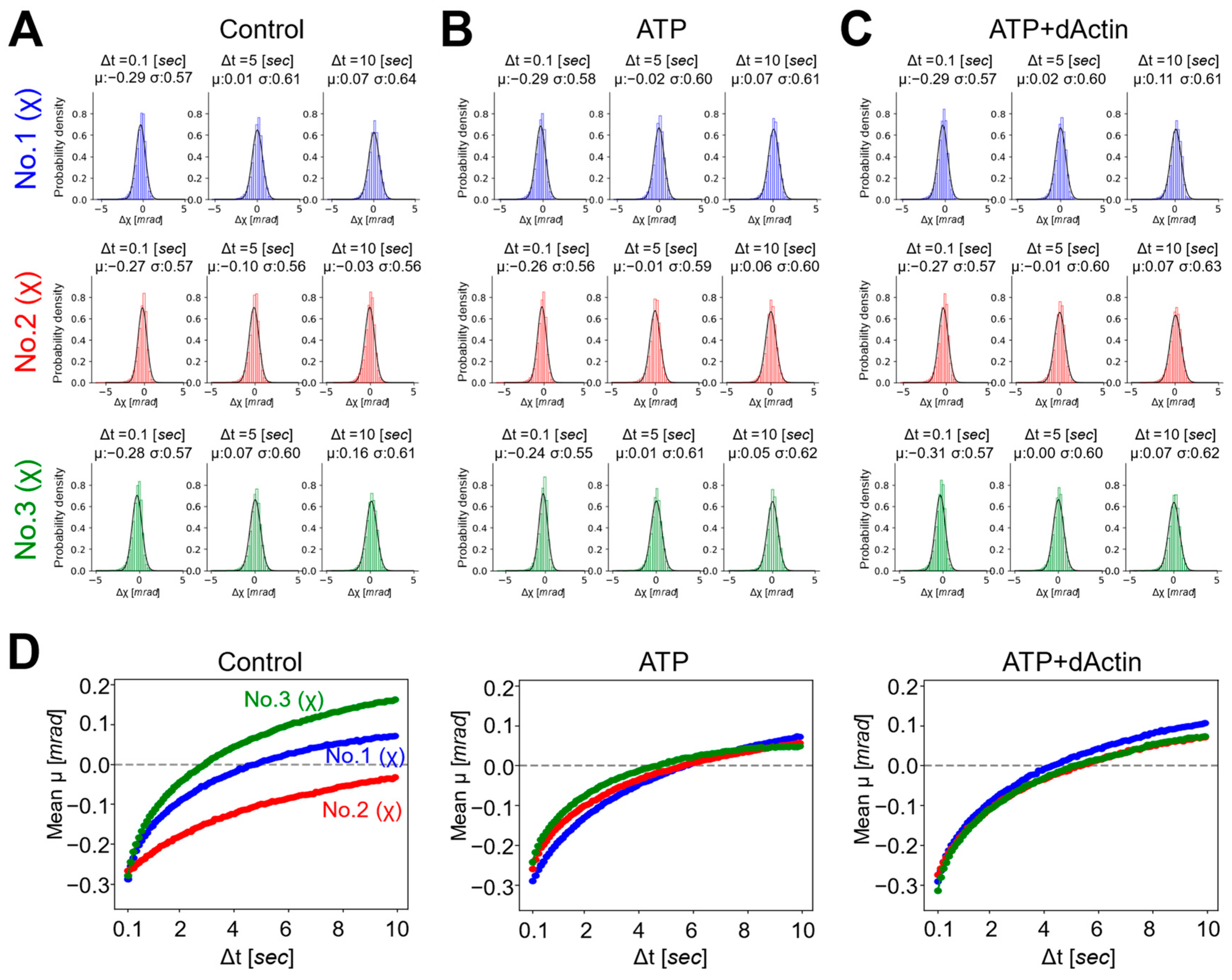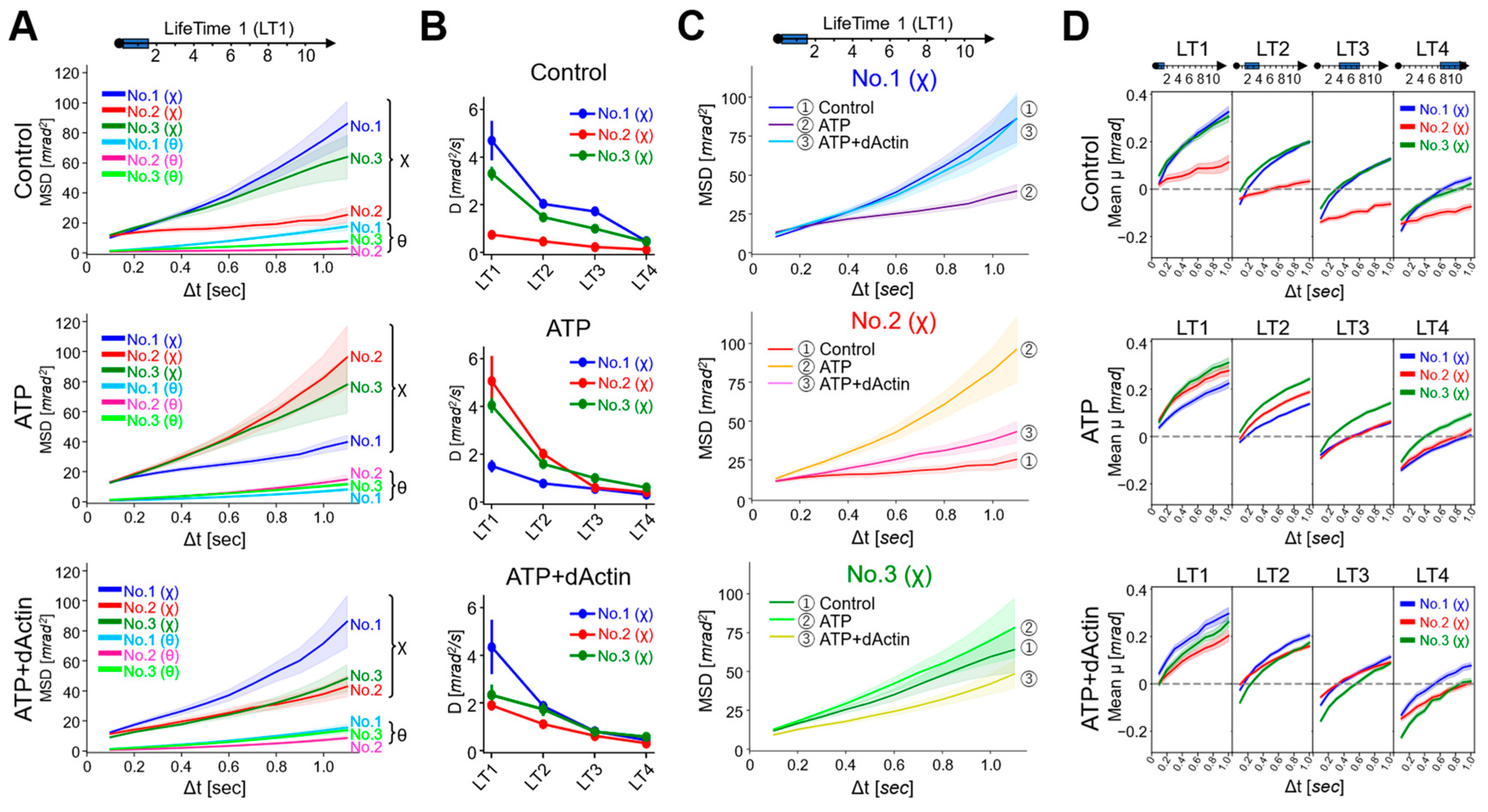Molecular Dynamics Mappings of the CCT/TRiC Complex-Mediated Protein Folding Cycle Using Diffracted X-ray Tracking
Abstract
:1. Introduction
2. Results
2.1. DXT Analysis of the CCT Complex
2.2. Dynamic of the CCT Complex in Different Structural Regions and Conditions
2.3. The Probability Distributions and the Mean Transitions of the Dynamics
2.4. Lifetime Classification of the Trajectories
3. Discussions

4. Materials and Methods
4.1. DNA Construction and Transfection
4.2. Purification of CCT Complex
4.3. DXT Measurements
4.4. Data Analysis for DXT
4.5. AFM Analysis
4.6. Electron Microscopy
Supplementary Materials
Author Contributions
Funding
Institutional Review Board Statement
Informed Consent Statement
Data Availability Statement
Acknowledgments
Conflicts of Interest
References
- Morales-Polanco, F.; Lee, J.H.; Barbosa, N.M.; Frydman, J. Cotranslational Mechanisms of Protein Biogenesis and Complex Assembly in Eukaryotes. Annu. Rev. Biomed. Data Sci. 2022, 5, 67–94. [Google Scholar] [CrossRef] [PubMed]
- Gestaut, D.; Limatola, A.; Joachimiak, L.; Frydman, J. The ATP-Powered Gymnastics of TRiC/CCT: An Asymmetric Protein Folding Machine with a Symmetric Origin Story. Curr. Opin. Struct. Biol. 2019, 55, 50–58. [Google Scholar] [CrossRef] [PubMed]
- Kubota, H. Function and Regulation of Cytosolic Molecular Chaperone CCT. Vitam. Horm. 2002, 65, 313–331. [Google Scholar] [CrossRef] [PubMed]
- Llorca, O.; Mccormack, E.A.; Hynes, G.; Grantham, J.J.; Cordell, J.; Carrascosa, J.L.; Willison, K.R.; Fernandez, J.J.; Valpuesta, J.M.; Carrascosa, L.; et al. Eukaryotic Type II Chaperonin CCT Interacts with Actin through Specific Subunits. Nature 1999, 402, 693–696. [Google Scholar] [CrossRef] [PubMed]
- Vainberg, I.E.; Melki, R.; Vainberg, I.E.; Chow, R.L.; Cowan, N.J. Chaperonin-Mediated Folding of Vertebrate Actin-Related Protein and Gamma-Tubulin. J. Cell Biol. 1993, 122, 1301–1310. [Google Scholar] [CrossRef]
- Llorca, O.; Martõ, J.; Ritco-Vonsovici, M.; Grantham, J.; Hynes, G.M.; Willison, K.R.; Carrascosa, Â.L.; Martín-Benito, J.; Ritco-Vonsovici, M.; Grantham, J.; et al. Eukaryotic Chaperonin CCT Stabilizes Actin and Tubulin Folding Intermediates in Open Quasi-Native Conformations. EMBO J. 2000, 19, 5971–5979. [Google Scholar] [CrossRef]
- Willison, K.R. The Structure and Evolution of Eukaryotic Chaperonin-Containing TCP-1 and Its Mechanism That Folds Actin into a Protein Spring. Biochem. J. 2018, 475, 3009–3034. [Google Scholar] [CrossRef]
- Araki, K.; Suenaga, A.; Kusano, H.; Tanaka, R.; Hatta, T.; Natsume, T.; Fukui, K. Functional Profiling of Asymmetrically-Organized Human CCT/TRiC Chaperonin. Biochem. Biophys. Res. Commun. 2016, 481, 232–238. [Google Scholar] [CrossRef]
- Fujii, Y.; Kaneko, M.; Neyazaki, M.; Nogi, T.; Kato, Y.; Takagi, J. PA Tag: A Versatile Protein Tagging System Using a Super High Affinity Antibody against a Dodecapeptide Derived from Human Podoplanin. Protein Expr. Purif. 2014, 95, 240–247. [Google Scholar] [CrossRef]
- Kalisman, N.; Schröder, G.F.; Levitt, M.; Structures, T.C.; Partitioning, I.F. The Crystal Structures of the Eukaryotic Chaperonin CCT Reveal Its Functional Partitioning. Structure 2013, 21, 540–549. [Google Scholar] [CrossRef]
- Reissmann, S.; Joachimiak, L.A.; Chen, B.; Meyer, A.S.; Nguyen, A.; Frydman, J. A Gradient of ATP Affinities Generates an Asymmetric Power Stroke Driving the Chaperonin TRIC/CCT Folding Cycle. Cell Rep. 2012, 2, 866–877. [Google Scholar] [CrossRef] [PubMed]
- Chagoyen, M.; Carrascosa, J.L.; Pazos, F.; Valpuesta, J.M. Molecular Determinants of the ATP Hydrolysis Asymmetry of the CCT Chaperonin Complex. Proteins Struct. Funct. Bioinform. 2014, 82, 703–707. [Google Scholar] [CrossRef] [PubMed]
- Yamamoto, Y.Y.; Abe, Y.; Moriya, K.; Arita, M.; Noguchi, K.; Ishii, N.; Sekiguchi, H.; Sasaki, Y.C.; Yohda, M. Inter-Ring Communication Is Dispensable in the Reaction Cycle of Group II Chaperonins. J. Mol. Biol. 2014, 426, 2667–2678. [Google Scholar] [CrossRef]
- Skjaerven, L.; Cuellar, J.; Martinez, A.; Valpuesta, J.M. Dynamics, Flexibility, and Allostery in Molecular Chaperonins. FEBS Lett. 2015, 589, 2522–2532. [Google Scholar] [CrossRef] [PubMed]
- Zang, Y.; Jin, M.; Wang, H.; Cui, Z.; Kong, L.; Liu, C.; Cong, Y. Staggered ATP Binding Mechanism of Eukaryotic Chaperonin TRiC (CCT) Revealed through High-Resolution Cryo-EM. Nat. Struct. Mol. Biol. 2016, 23, 1083–1091. [Google Scholar] [CrossRef] [PubMed]
- Chaperonin, E.; Cct, T. Article The Structural Basis of Substrate Recognition by The. Cell 2014, 159, 1042–1055. [Google Scholar] [CrossRef]
- Balchin, D.; Miličić, G.; Strauss, M.; Hayer-Hartl, M.; Hartl, F.U. Pathway of Actin Folding Directed by the Eukaryotic Chaperonin TRiC. Cell 2018, 174, 1507–1521.e16. [Google Scholar] [CrossRef]
- Gestaut, D.; Zhao, Y.; Park, J.; Ma, B.; Leitner, A.; Collier, M.; Pintilie, G.; Roh, S.H.; Chiu, W.; Frydman, J. Structural Visualization of the Tubulin Folding Pathway Directed by Human Chaperonin TRiC/CCT. Cell 2022, 185, 4770–4787.e20. [Google Scholar] [CrossRef]
- Gestaut, D.; Roh, S.H.; Ma, B.; Pintilie, G.; Joachimiak, L.A.; Leitner, A.; Walzthoeni, T.; Aebersold, R.; Chiu, W.; Frydman, J. The Chaperonin TRiC/CCT Associates with Prefoldin through a Conserved Electrostatic Interface Essential for Cellular Proteostasis. Cell 2019, 177, 751–765.e15. [Google Scholar] [CrossRef]
- Liu, C.; Jin, M.; Wang, S.; Han, W.; Zhao, Q.; Wang, Y.Y.; Xu, C.; Diao, L.; Yin, Y.; Peng, C.; et al. Pathway and Mechanism of Tubulin Folding Mediated by TRiC/CCT along Its ATPase Cycle Revealed Using Cryo-EM. Commun. Biol. 2023, 6, 531. [Google Scholar] [CrossRef]
- Sasaki, Y.C.; Suzuki, Y.; Yagi, N.; Adachi, S.; Ishibashi, M.; Suda, H.; Toyota, K.; Yanagihara, M. Tracking of Individual Nanocrystals Using Diffracted x Rays. Phys. Rev. E 2000, 62, 3843–3847. [Google Scholar] [CrossRef] [PubMed]
- Fujimura, S.; Mio, K.; Ohkubo, T.; Arai, T.; Kuramochi, M.; Sekiguchi, H.; Sasaki, Y.C. Diffracted X-Ray Tracking Method for Measuring Intramolecular Dynamics of Membrane Proteins. Int. J. Mol. Sci. 2022, 23, 2343. [Google Scholar] [CrossRef] [PubMed]
- Ohkubo, T.; Shiina, T.; Kawaguchi, K.; Sasaki, D.; Inamasu, R.; Yang, Y.; Li, Z.; Taninaka, K.; Sakaguchi, M.; Fujimura, S.; et al. Visualizing Intramolecular Dynamics of Membrane Proteins. Int. J. Mol. Sci. 2022, 23, 14539. [Google Scholar] [CrossRef] [PubMed]
- Sato-Tomita, A.; Sekiguchi, H.; Sasaki, Y.C. Progression of 3D Protein Structure and Dynamics Measurements. J. Phys. Soc. Jpn. 2018, 87, 061015. [Google Scholar] [CrossRef]
- Sekiguchi, H.; Nakagawa, A.; Moriya, K.; Makabe, K.; Ichiyanagi, K.; Nozawa, S.; Sato, T.; Adachi, S.; Kuwajima, K.; Yohda, M.; et al. ATP Dependent Rotational Motion of Group II Chaperonin Observed by X-Ray Single Molecule Tracking. PLoS ONE 2013, 8, e64176. [Google Scholar] [CrossRef]
- Yamamoto, Y.Y.; Uno, Y.; Sha, E.; Ikegami, K.; Ishii, N.; Dohmae, N.; Sekiguchi, H.; Sasaki, Y.C.; Yohda, M. Asymmetry in the Function and Dynamics of the Cytosolic Group II Chaperonin CCT/TRiC. PLoS ONE 2017, 12, e0176054. [Google Scholar] [CrossRef]
- Pereira, J.H.; Ralston, C.Y.; Douglas, N.R.; Kumar, R.; Lopez, T.; McAndrew, R.P.; Knee, K.M.; King, J.A.; Frydman, J.; Adams, P.D. Mechanism of Nucleotide Sensing in Group II Chaperonins. EMBO J. 2012, 31, 731–740. [Google Scholar] [CrossRef]
- Höfling, F.; Franosch, T. Anomalous Transport in the Crowded World of Biological Cells. Rep. Prog. Phys. 2013, 76, 046602. [Google Scholar] [CrossRef]
- Fujimura, S.; Mio, K.; Kuramochi, M.; Sekiguchi, H.; Ikezaki, K.; Mio, M.; Hengphasatporn, K.; Shigeta, Y.; Kubo, T.; Sasaki, Y.C. Agonist and Antagonist-Diverted Twisting Motions of a Single TRPV1 Channel. J. Phys. Chem. B 2020, 124, 11617–11624. [Google Scholar] [CrossRef]
- Cong, Y.; Schröder, G.F.; Meyer, A.S.; Jakana, J.; Ma, B.; Dougherty, M.T.; Schmid, M.F.; Reissmann, S.; Levitt, M.; Ludtke, S.L.; et al. Symmetry-Free Cryo-EM Structures of the Chaperonin TRiC along Its ATPase-Driven Conformational Cycle. EMBO J. 2012, 31, 720–730. [Google Scholar] [CrossRef]
- Zhang, J.; Ma, B.; Dimaio, F.; Douglas, N.R.; Joachimiak, L.A.; Baker, D.; Frydman, J.; Levitt, M.; Chiu, W. Cryo-EM Structure of a Group II Chaperonin in the Prehydrolysis ATP-Bound State Leading to Lid Closure. Structure 2011, 19, 633–639. [Google Scholar] [CrossRef] [PubMed]
- Kinjo, A.R.; Bekker, G.J.; Wako, H.; Endo, S.; Tsuchiya, Y.; Sato, H.; Nishi, H.; Kinoshita, K.; Suzuki, H.; Kawabata, T.; et al. New Tools and Functions in Data-out Activities at Protein Data Bank Japan (PDBj). Protein Sci. 2018, 27, 95–102. [Google Scholar] [CrossRef] [PubMed]
- Wako, H.; Endo, S. Normal Mode Analysis Based on an Elastic Network Model for Biomolecules in the Protein Data Bank, Which Uses Dihedral Angles as Independent Variables. Comput. Biol. Chem. 2013, 44, 22–30. [Google Scholar] [CrossRef] [PubMed]
- Wako, H.; Kato, M.; Endo, S. ProMode: A Database of Normal Mode Analyses on Protein Molecules with a Full-Atom Model. Bioinformatics 2004, 20, 2035–2043. [Google Scholar] [CrossRef]
- Wako, H.; Endo, S. Normal Mode Analysis as a Method to Derive Protein Dynamics Information from the Protein Data Bank. Biophys. Rev. 2017, 9, 877–893. [Google Scholar] [CrossRef]
- Han, W.; Jin, M.; Liu, C.; Zhao, Q.; Wang, S.; Wang, Y.Y.Y.; Yin, Y.; Peng, C.; Wang, Y.Y.Y.; Cong, Y. Structural Basis of Plp2-Mediated Cytoskeletal Protein Folding by TRiC/CCT. Sci. Adv. 2023, 9, 1–14. [Google Scholar] [CrossRef]
- Kelly, J.J.; Tranter, D.; Pardon, E.; Chi, G.; Kramer, H.; Happonen, L.; Knee, K.M.; Janz, J.M.; Steyaert, J.; Bulawa, C.; et al. Snapshots of Actin and Tubulin Folding inside the TRiC Chaperonin. Nat. Struct. Mol. Biol. 2022, 29, 420–429. [Google Scholar] [CrossRef]
- Douglas, N.R.; Reissmann, S.; Zhang, J.; Chen, B.; Jakana, J.; Kumar, R.; Chiu, W.; Frydman, J. Dual Action of ATP Hydrolysis Couples Lid Closure to Substrate Release into the Group II Chaperonin Chamber. Cell 2011, 144, 240–252. [Google Scholar] [CrossRef]
- Leitner, A.; Joachimiak, L.A.; Bracher, A.; Mönkemeyer, L.; Walzthoeni, T.; Chen, B.; Pechmann, S.; Holmes, S.; Cong, Y.; Ma, B.; et al. The Molecular Architecture of the Eukaryotic Chaperonin TRiC/CCT. Structure 2012, 20, 814–825. [Google Scholar] [CrossRef]
- Bigotti, M.G.; Bellamy, S.R.W.; Clarke, A.R. The Asymmetric ATPase Cycle of the Thermosome: Elucidation of the Binding, Hydrolysis and Product-Release Steps. J. Mol. Biol. 2006, 362, 835–843. [Google Scholar] [CrossRef]
- Frydman, J.; Nimmesgern, E.; Erdjument-Bromage1, H.; Wall2, J.S.; Tempst1, P.; Hartl3, F.-U.; Erdjument-Bromage, H.; Wall, J.S.; Tempst, P.; Hartl, F.U.F.U.; et al. Function in Protein Folding of TRiC, a Cytosolic Ring Complex Containing TCP-1 and Structurally Related Subunits. EMBO J. 1992, 11, 4767–4778. [Google Scholar] [CrossRef]
- Reissmann, S.; Parnot, C.; Booth, C.R.; Chiu, W.; Frydman, J. Essential Function of the Built-in Lid in the Allosteric Regulation of Eukaryotic and Archaeal Chaperonins. Nat. Struct. Mol. Biol. 2007, 14, 432–440. [Google Scholar] [CrossRef]
- Melki, R.; Cowan, N.J. Facilitated Folding of Actins and Tubulins Occurs via a Nucleotide-Dependent Interaction between Cytoplasmic Chaperonin and Distinctive Folding Intermediates. Mol. Cell. Biol. 1994, 14, 2895–2904. [Google Scholar] [CrossRef] [PubMed]
- Bahar, I.; Cheng, M.H.; Lee, J.Y.; Kaya, C.; Zhang, S. Structure-Encoded Global Motions and Their Role in Mediating Protein-Substrate Interactions. Biophys. J. 2015, 109, 1101–1109. [Google Scholar] [CrossRef] [PubMed]
- Chacón, P.; Tama, F.; Wriggers, W. Mega-Dalton Biomolecular Motion Captured from Electron Microscopy Reconstructions. J. Mol. Biol. 2003, 326, 485–492. [Google Scholar] [CrossRef] [PubMed]
- Zhang, S.; Krieger, J.M.; Zhang, Y.; Kaya, C.; Kaynak, B.; Mikulska-Ruminska, K.; Doruker, P.; Li, H.; Bahar, I. ProDy 2.0: Increased Scale and Scope after 10 Years of Protein Dynamics Modelling with Python. Bioinformatics 2021, 37, 3657–3659. [Google Scholar] [CrossRef] [PubMed]
- Zhang, Y.; Krieger, J.; Mikulska-Ruminska, K.; Kaynak, B.; Sorzano, C.O.S.; Carazo, J.M.; Xing, J.; Bahar, I. State-Dependent Sequential Allostery Exhibited by Chaperonin TRiC/CCT Revealed by Network Analysis of Cryo-EM Maps. Prog. Biophys. Mol. Biol. 2021, 160, 104–120. [Google Scholar] [CrossRef] [PubMed]
- Zhang, J.; Baker, M.L.; Schröder, G.F.; Douglas, N.R.; Reissmann, S.; Jakana, J.; Dougherty, M.; Fu, C.J.; Levitt, M.; Ludtke, S.J.; et al. Mechanism of Folding Chamber Closure in a Group II Chaperonin. Nature 2010, 463, 379–383. [Google Scholar] [CrossRef]
- Rivenzon-Segal, D.; Wolf, S.G.; Shimon, L.; Willison, K.R.; Horovitz, A. Sequential ATP-Induced Allosteric Transitions of the Cytoplasmic Chaperonin Containing TCP-1 Revealed by EM Analysis. Nat. Struct. Mol. Biol. 2005, 12, 233–237. [Google Scholar] [CrossRef]
- Muñoz, I.G.; Yébenes, H.; Zhou, M.; Mesa, P.; Serna, M.; Park, A.Y.; Bragado-Nilsson, E.; Beloso, A.; de Cárcer, G.; Malumbres, M.; et al. Crystal Structure of the Open Conformation of the Mammalian Chaperonin CCT in Complex with Tubulin. Nat. Struct. Mol. Biol. 2011, 18, 14–19. [Google Scholar] [CrossRef]
- Kafri, G.; Horovitz, A. Transient Kinetic Analysis of ATP-Induced Allosteric Transitions in the Eukaryotic Chaperonin Containing TCP-1. J. Mol. Biol. 2003, 326, 981–987. [Google Scholar] [CrossRef] [PubMed]
- Gruber, R.; Horovitz, A. Allosteric Mechanisms in Chaperonin Machines. Chem. Rev. 2016, 116, 6588–6606. [Google Scholar] [CrossRef] [PubMed]
- Mio, K.; Ohkubo, T.; Sasaki, D.; Arai, T.; Sugiura, M.; Fujimura, S.; Nozawa, S.; Sekiguchi, H.; Kuramochi, M.; Sasaki, Y.C. Real-Time Observation of Capsaicin-Induced Intracellular Domain Dynamics of TRPV1 Using the Diffracted X-ray Tracking Method. Membranes 2023, 13, 708. [Google Scholar] [CrossRef] [PubMed]
- Watanabe-Nakayama, T.; Tsuji, M.; Umeda, K.; Oguchi, T.; Konno, H.; Noguchi-Shinohara, M.; Kiuchi, Y.; Kodera, N.; Teplow, D.B.; Ono, K. Structural Dynamics of Amyloid-β Protofibrils and Actions of Anti-Amyloid-β Antibodies as Observed by High-Speed Atomic Force Microscopy. Nano Lett. 2023, 23, 6259–6268. [Google Scholar] [CrossRef]
- Uchihashi, T.; Kodera, N.; Ando, T. Guide to Video Recording of Structure Dynamics and Dynamic Processes of Proteins by High-Speed Atomic Force Microscopy. Nat. Protoc. 2012, 7, 1193–1206. [Google Scholar] [CrossRef]
- Ando, T.; Kodera, N.; Takai, E.; Maruyama, D.; Saito, K.; Toda, A. A High-Speed Atomic Force Microscope for Studying Biological Macromolecules. Proc. Natl. Acad. Sci. USA 2001, 98, 12468–12472. [Google Scholar] [CrossRef]
- Ando, T.; Uchihashi, T.; Fukuma, T. High-Speed Atomic Force Microscopy for Nano-Visualization of Dynamic Biomolecular Processes. Prog. Surf. Sci. 2008, 83, 337–437. [Google Scholar] [CrossRef]
- Kodera, N.; Yamamoto, D.; Ishikawa, R.; Ando, T. Video Imaging of Walking Myosin v by High-Speed Atomic Force Microscopy. Nature 2010, 468, 72–76. [Google Scholar] [CrossRef]




| Condition | Total | LT1 | LT2 | LT3 | LT4 | |
|---|---|---|---|---|---|---|
| Control | No.1 | 25,808 | 11,486 (83.4) | 1334 (9.7) | 438 (3.2) | 515 (3.7) |
| No.2 | 13,773 | 18,334 (82.4) | 2470 (11.1) | 738 (3.3) | 701 (3.2) | |
| No.3 | 22,243 | 25,515 (80.7) | 3570 (11.3) | 1211 (3.8) | 1310 (4.1) | |
| ATP | No.1 | 31,606 | 19,342 (82.8) | 2497 (10.7) | 710 (3.0) | 807 (3.5) |
| No.2 | 23,356 | 23,839 (83.2) | 3044 (10.6) | 891 (3.1) | 893 (3.1) | |
| No.3 | 28,667 | 13,634 (84.0) | 1671 (10.3) | 473 (2.9) | 447 (2.8) | |
| ATP+dActin | No.1 | 16,225 | 15,907 (81.5) | 2156 (11.0) | 761 (3.9) | 704 (3.6) |
| No.2 | 19,528 | 13,731 (81.9) | 1897 (11.3) | 590 (3.5) | 555 (3.3) | |
| No.3 | 16,773 | 11,486 (83.4) | 1334 (9.7) | 438 (3.2) | 515 (3.7) |
Disclaimer/Publisher’s Note: The statements, opinions and data contained in all publications are solely those of the individual author(s) and contributor(s) and not of MDPI and/or the editor(s). MDPI and/or the editor(s) disclaim responsibility for any injury to people or property resulting from any ideas, methods, instructions or products referred to in the content. |
© 2023 by the authors. Licensee MDPI, Basel, Switzerland. This article is an open access article distributed under the terms and conditions of the Creative Commons Attribution (CC BY) license (https://creativecommons.org/licenses/by/4.0/).
Share and Cite
Araki, K.; Watanabe-Nakayama, T.; Sasaki, D.; Sasaki, Y.C.; Mio, K. Molecular Dynamics Mappings of the CCT/TRiC Complex-Mediated Protein Folding Cycle Using Diffracted X-ray Tracking. Int. J. Mol. Sci. 2023, 24, 14850. https://doi.org/10.3390/ijms241914850
Araki K, Watanabe-Nakayama T, Sasaki D, Sasaki YC, Mio K. Molecular Dynamics Mappings of the CCT/TRiC Complex-Mediated Protein Folding Cycle Using Diffracted X-ray Tracking. International Journal of Molecular Sciences. 2023; 24(19):14850. https://doi.org/10.3390/ijms241914850
Chicago/Turabian StyleAraki, Kazutaka, Takahiro Watanabe-Nakayama, Daisuke Sasaki, Yuji C. Sasaki, and Kazuhiro Mio. 2023. "Molecular Dynamics Mappings of the CCT/TRiC Complex-Mediated Protein Folding Cycle Using Diffracted X-ray Tracking" International Journal of Molecular Sciences 24, no. 19: 14850. https://doi.org/10.3390/ijms241914850
APA StyleAraki, K., Watanabe-Nakayama, T., Sasaki, D., Sasaki, Y. C., & Mio, K. (2023). Molecular Dynamics Mappings of the CCT/TRiC Complex-Mediated Protein Folding Cycle Using Diffracted X-ray Tracking. International Journal of Molecular Sciences, 24(19), 14850. https://doi.org/10.3390/ijms241914850








